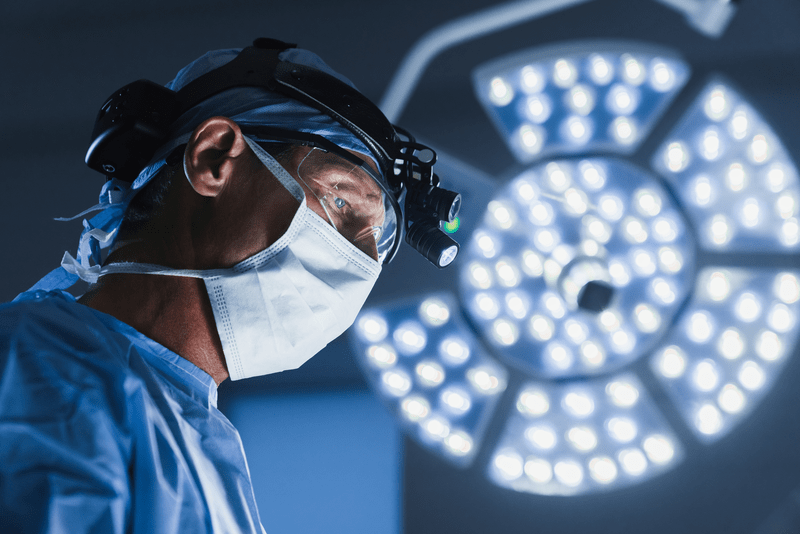Why choose Riverside for your cancer surgery?
- Cancer Specialized Surgeons: Our surgical oncologists are board certified and fellowship trained with expertise in treating cancer.
- Advanced technology and surgical techniques: Riverside offers DaVinci advanced robotic surgery, minimally invasive laparoscopic surgery and traditional approaches.
- Multidisciplinary care: Our surgeons work collaboratively across all specialties so your care is coordinated and integrated, ensuring you receive the most effective treatment, individualized to you.
- Commitment to safety, quality and precision: Our surgery program is part of our cancer care network’s nationally accredited program recognized by the American College of Surgeons Commission on Cancer (CoC) and the National Accreditation Program for Breast Centers (NAPBC). These accreditations are an indicator of our commitment to delivering high-quality, patient centered care through evidence-based treatment, continuous quality improvement and a robust multidisciplinary approach.
- Supportive services before, during and after surgery: From cancer nurse navigation, nutrition and oncology rehabilitation, we provide you support to help you heal and recover.
Meet our Experts
Whether your care requires a complex resection, a minimally invasive procedure or a highly specialized surgical technique, our surgical oncologists and surgeons bring extensive expertise in treating cancer.
Our team includes surgical oncologists, general surgeons, thoracic surgeons and others surgical specialists who are here to help you through your cancer journey.
Multidisciplinary approach
Our surgeons collaborate with medical oncologists, radiation oncologists, radiologists, pathologists, genetic counselors, nurse navigators and other members of our cancer network to provide you with the highest quality care.
One of the ways they collaborate is through weekly multidisciplinary tumor boards. During the tumor boards experts discuss your imaging, pathology and clinical details along with your health history and logistical needs. Patients benefit from the collective experience and guidance of cancer specialists from across our network with the singular goal to create the most effective, individualized treatment plan for you.
There are different reasons you may need surgery when facing a cancer diagnosis. Your surgeon will spend time with you explaining your imaging results and discussing where surgery may be recommended as part of your personalized treatment plan.
Surgery can play several roles in cancer care, to include:
Diagnostic Surgery
Diagnostic surgery can be done to confirm or rule out a suspected cancer, or can be used to determine the extent of your cancer so the most effective treatment can be planned. During this type of procedure, a small amount of tissue may be removed so a pathologist can look at it under a microscope to determine if cancer is present, and perform other testing to select the best option for your care. Diagnostic surgery can also be investigative, where a laparoscope is used to visually examine internal organs in the abdomen and pelvis and areas of suspicion can be biopsied.
Curative Surgery
When cancer is detected at an early stage and has not spread to other parts of the body, curative surgery may be used to remove the tumor and a margin of surrounding healthy tissue. Curative surgery is done with the goal of achieving a cure or remission. Curative surgery may be used alone or in conjunction with chemotherapy, immunotherapy or radiation therapy.
Staging Surgery
In order to determine the most effective treatment, your oncologist will need to understand the extent of your cancer and if it has spread. Your oncologist will be looking for the size and extent of your primary tumor, if the cancer has spread to nearby lymph nodes and if the cancer has spread to other parts of your body. Surgery can sometimes be used to assist in this investigation.
Cytoreductive Surgery
Depending on the size and origin of your tumor, there are times when the entire tumor may not be safely removed. Cytoreductive surgery removes as much of the tumor as possible, allowing other treatments, such as chemotherapy, immunotherapy or radiation, to work more effectively as there is a smaller amount of cancer to treat.
Palliative Surgery
Palliative surgery can improve your quality of life, relieving pain and discomfort when your cancer is at an advanced stage and may not be curable.
Reconstructive Surgery
Reconstructive surgery is a highly individualized surgical procedure performed to restore appearance or function, especially after breast or head and neck surgery. Reconstructive surgery may be integrated into your primary surgery or done at a later time. Your reconstructive surgeon will collaborate with other members of your cancer care team to discuss reconstructive options and optimal timing, so you can choose a plan that works best for you.
Supportive Procedures
During your cancer treatment surgery may be required to assist the other members of the treatment team in more effectively managing your cancer. Examples of supportive surgery include
- Your surgeon places a port under your skin to make chemotherapy treatment easier and more comfortable
- Your surgeon places a feeding tube that will be used to deliver medications and nutrition
Preventive Surgery
Preventive surgery is a risk reducing surgery, also known as prophylactic surgery. Preventive surgery is a consideration for those people at highest risk due to a strong family history of certain cancers and those who are known to have a genetic mutation. Preventive surgery removes tissue that has a high risk of developing cancer in the future, even though the tissue currently may not contain cancer.
Before choosing to have preventive surgery, you will have thoughtful and informative discussions with your health care team to fully understand the risks and benefits.
Examples of preventive surgery include:
- prophylactic mastectomy to remove breast tissue
- prophylactic oophorectomy to remove ovaries
- prophylactic colectomy to remove all or a portion on your colon
While preventive surgery greatly reduces cancer risk, patients should still continue to undergo screening and surveillance.
Diagnostic surgery can be done to confirm or rule out a suspected cancer, or can be used to determine the extent of your cancer so the most effective treatment can be planned. During this type of procedure, a small amount of tissue may be removed so a pathologist can look at it under a microscope to determine if cancer is present, and perform other testing to select the best option for your care. Diagnostic surgery can also be investigative, where a laparoscope is used to visually examine internal organs in the abdomen and pelvis and areas of suspicion can be biopsied.
When cancer is detected at an early stage and has not spread to other parts of the body, curative surgery may be used to remove the tumor and a margin of surrounding healthy tissue. Curative surgery is done with the goal of achieving a cure or remission. Curative surgery may be used alone or in conjunction with chemotherapy, immunotherapy or radiation therapy.
In order to determine the most effective treatment, your oncologist will need to understand the extent of your cancer and if it has spread. Your oncologist will be looking for the size and extent of your primary tumor, if the cancer has spread to nearby lymph nodes and if the cancer has spread to other parts of your body. Surgery can sometimes be used to assist in this investigation.
Depending on the size and origin of your tumor, there are times when the entire tumor may not be safely removed. Cytoreductive surgery removes as much of the tumor as possible, allowing other treatments, such as chemotherapy, immunotherapy or radiation, to work more effectively as there is a smaller amount of cancer to treat.
Palliative surgery can improve your quality of life, relieving pain and discomfort when your cancer is at an advanced stage and may not be curable.
Reconstructive surgery is a highly individualized surgical procedure performed to restore appearance or function, especially after breast or head and neck surgery. Reconstructive surgery may be integrated into your primary surgery or done at a later time. Your reconstructive surgeon will collaborate with other members of your cancer care team to discuss reconstructive options and optimal timing, so you can choose a plan that works best for you.
During your cancer treatment surgery may be required to assist the other members of the treatment team in more effectively managing your cancer. Examples of supportive surgery include
- Your surgeon places a port under your skin to make chemotherapy treatment easier and more comfortable
- Your surgeon places a feeding tube that will be used to deliver medications and nutrition
Preventive surgery is a risk reducing surgery, also known as prophylactic surgery. Preventive surgery is a consideration for those people at highest risk due to a strong family history of certain cancers and those who are known to have a genetic mutation. Preventive surgery removes tissue that has a high risk of developing cancer in the future, even though the tissue currently may not contain cancer.
Before choosing to have preventive surgery, you will have thoughtful and informative discussions with your health care team to fully understand the risks and benefits.
Examples of preventive surgery include:
- prophylactic mastectomy to remove breast tissue
- prophylactic oophorectomy to remove ovaries
- prophylactic colectomy to remove all or a portion on your colon
While preventive surgery greatly reduces cancer risk, patients should still continue to undergo screening and surveillance.
Riverside offers DaVinci advanced robotic surgery, minimally invasive laparoscopic surgery and traditional approaches. There are many considerations for which surgical technique is best for you.
You will have dedicated time with your surgeon to talk through the recommended options, along with the inherent risks and benefits. Your surgeon will answer any questions you or your family may have so you’ll have the information you need to make the best decision for you.
Your surgeon may recommend minimally invasive surgery. Benefits of this surgical technique include:
- Reduced pain and need for medication
- Reduced recovery time
- Reduced blood loss
- Reduced risk of infection
- Reduced length of stay in hospital
Our fellowship trained interventional endoscopists provide expert care utilizing state-of-the-art imaging and advanced endoscopic techniques. Also known as interventional endoscopy, this minimally invasive approach allows for the precise diagnosis, management and treatment of complex gastroenterological conditions.
Click here to learn more about advanced endoscopic care.
Precision, quality and safety in every surgical procedure
Our surgeons are skilled in navigating complex cases and advanced cancers. Their skill and expertise combined with their experience allow them to perform surgical cases safely with a focus on you and your care. Our goals in providing cancer surgery, include:
- Your safety and comfort
- Precision in protecting healthy tissue
- Protocols to support healing and recovery and minimize risk of infections
- Coordination with oncology rehabilitation
- Technology that reduces hospital stays and reduces pain
- A team of coordinated cancer professionals to help navigate journey from diagnosis through survivorship
Role of prehabilitation
Prehabilitation can prepare your body to be able to successfully undergo cancer treatment. Building strength before surgery can support reduced complications, shorter hospital stays and the ability to return to normal activities earlier.
After surgery, oncology rehabilitation may be part of your treatment plan. The function of this specialized therapy is designed to improve your quality of life and support your recovery.
Physical therapy to regain strength, flexibility and energy.
Lymphedema therapy to prevent, manage and treat swelling and discomfort that may occur after lymph nodes are removed.
Pelvic floor physical therapy for bladder, bowel or sexual function issues.
Occupational therapy to regain strength, flexibility and energy to allow the performance of normal daily activities.
Speech therapy to assist patients with swallowing and eating difficulties or difficulties in communication.

